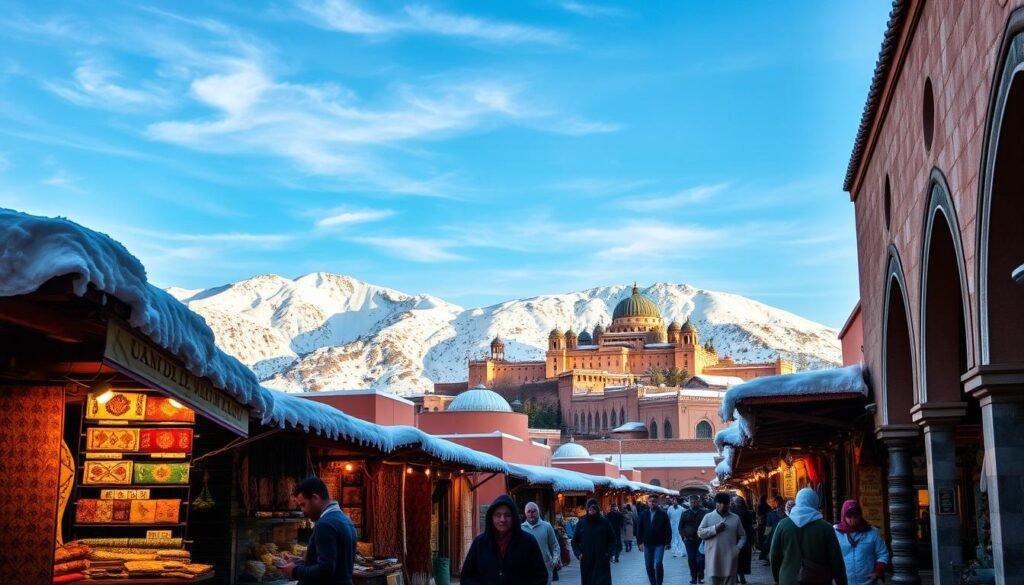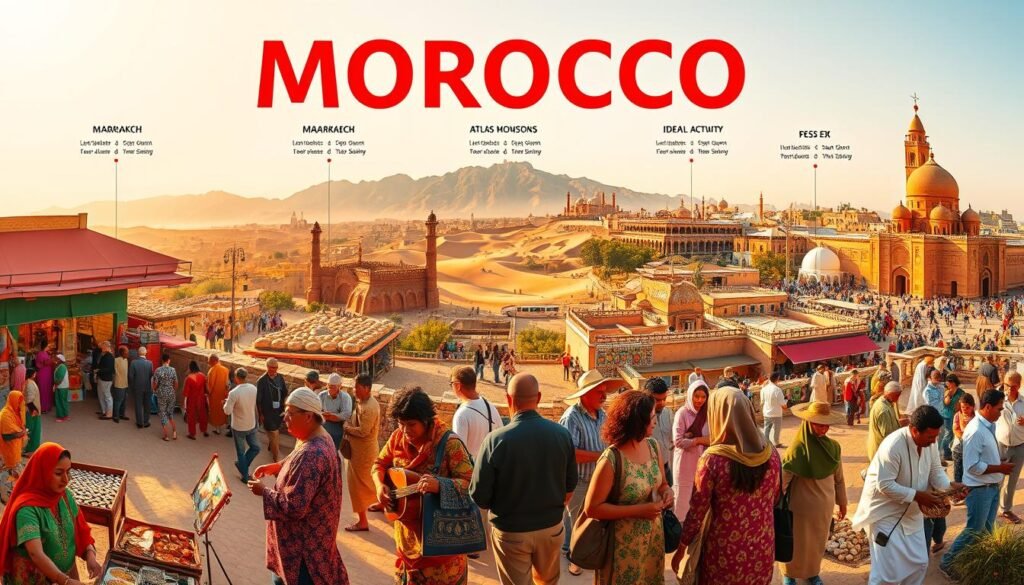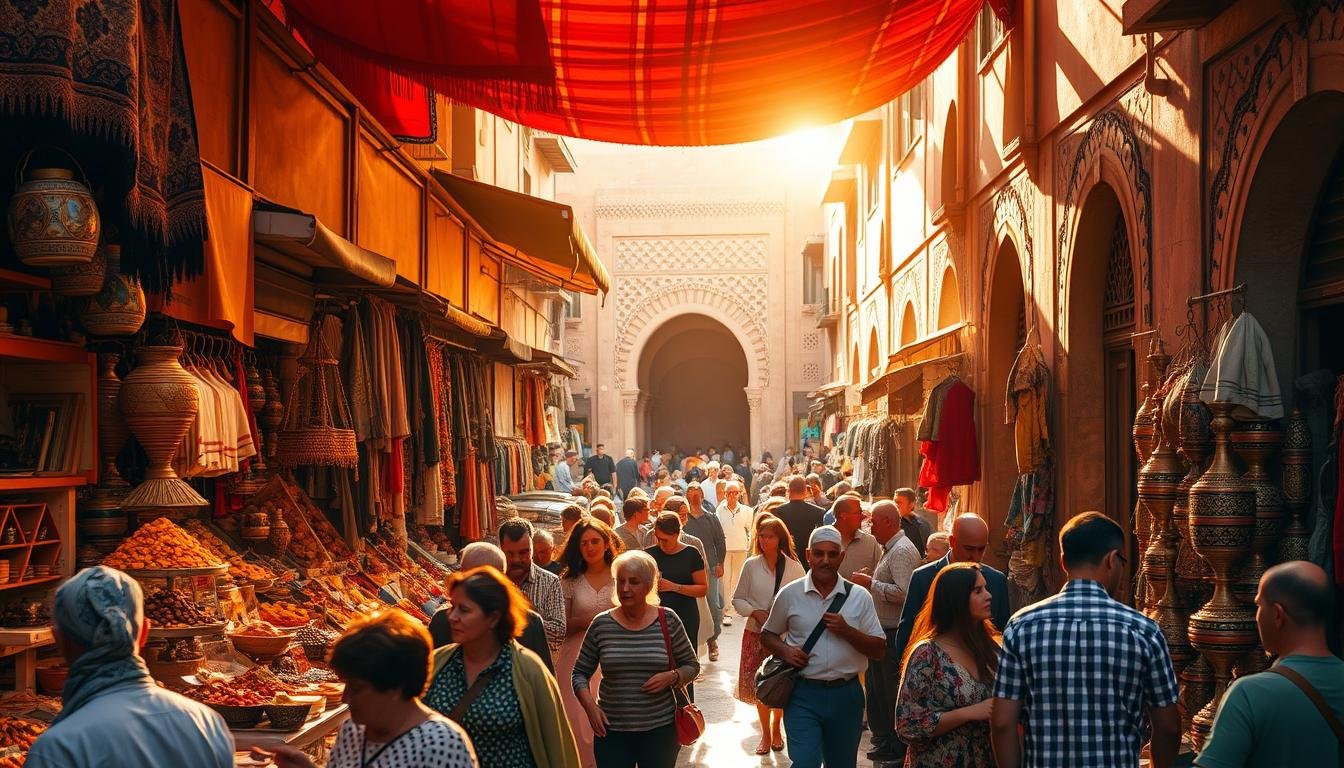Best time to Visit Morocco. Weather and events
Did you know Morocco’s weather changes a lot? It goes from very hot desert to cool Atlas Mountains. So, picking the right Morocco travel season is key for a great trip.
Whether you love cultural festivals or peaceful landscapes, knowing when to go is important. Morocco is lively in Marrakech and calm in the Sahara Desert. Every season has its own charm.
Key Takeaways
- Morocco’s climate varies greatly across different regions.
- The ideal travel season depends on your preferences and itinerary.
- Cultural festivals and events are a significant part of Morocco’s appeal.
- Understanding the best time to visit can enhance your travel experience.
- Morocco offers diverse landscapes and experiences across all seasons.
Morocco’s Climate Overview: What to Expect Year-Round
Planning a trip to Morocco? It’s key to know the country’s climate. Morocco’s weather changes a lot because of its geography. You’ll find coastal areas, mountains, deserts, and the Mediterranean coast.
Knowing about the climate zones and travel seasons can make your trip better. Morocco offers exciting experiences all year. Whether you want city life, peaceful landscapes, or cultural events, Morocco has it all.
The Four Distinct Climate Zones
Morocco has four main climate zones. The coastal regions have a mild climate, thanks to the Atlantic Ocean. The Atlas Mountains are cold, perfect for skiing in winter. The desert regions are hot during the day and cold at night. The Mediterranean coast has warm summers and mild winters.
- Coastal regions: Mild climate, moderate temperatures.
- Atlas Mountains: Cold winters, ideal for skiing.
- Desert regions: Extreme heat and cold variations.
- Mediterranean coast: Temperate climate, warm summers.
Understanding Peak, Shoulder, and Off-Season Travel
The peak tourist season in Morocco is summer and holidays. It’s busy with lots of visitors. The shoulder season, from April to May and September to November, has nice weather and fewer people. The off-season, winter, is cheaper and quieter.
- Peak Season: Summer and holidays, bustling with tourists.
- Shoulder Season: April to May and September to November, comfortable weather and fewer crowds.
- Off-Season: Winter months, ideal for budget travelers and those seeking solitude.
Best Time to Visit Morocco: Season-by-Season Breakdown
Morocco has different landscapes and climates. The best time to visit depends on what you like to do. Each season offers unique experiences, making it a great place to visit all year.
Optimal Visiting Windows for Different Travelers
Spring (March to May) and fall (September to November) are the best times to see Morocco. These seasons have nice weather, from 65°F to 75°F (18°C to 24°C). You’ll also find many cultural events.
- Mild weather is perfect for city tours in Marrakech and Fes.
- It’s great for hiking in the Atlas Mountains.
- Don’t miss the Marrakech Popular Arts Festival in July, even though some events happen in shoulder seasons.
When to Avoid: Challenging Weather Periods
While Morocco is always open, some times are better than others. Summer (June to August) is very hot, with desert temperatures over 100°F (38°C). On the other hand, winters (December to February) can be chilly, with snow in the mountains.
Some weather challenges to keep in mind:
- Summer in the Sahara Desert is extremely hot.
- Winter in the Atlas Mountains can be cold, with snow.
- Coastal areas might see rain in winter.
Spring in Morocco: March to May
Spring in Morocco is magical, with cultural festivals and nice weather. The landscapes are stunning, with flowers and greenery blooming.
Temperature and Rainfall Expectations
Spring in Morocco has mild temperatures, from 15°C to 25°C (59°F to 77°F). It’s perfect for exploring. Rainfall drops, making outdoor activities smooth by May.
Must-Experience Spring Events
Spring in Morocco is more than just good weather. It’s also a time for lively cultural festivals. Two top events are the Rose Festival in Kelaat M’Gouna and the Sufi Cultural Festival.
Rose Festival in Kelaat M’Gouna
The Rose Festival honors the rose harvest with music, dance, and fun. It’s a chance to dive into local culture.
Sufi Cultural Festival
The Sufi Cultural Festival shows Morocco’s spiritual side with amazing performances and rituals.
Ideal Spring Destinations and Activities
Spring is great for visiting places like Marrakech, the Atlas Mountains, and coastal towns. Enjoy hiking, market exploration, and beach relaxation.
A seasoned traveler once said, “Morocco in spring is a feast for the senses. It offers vibrant colors, pleasant weather, and rich cultural experiences.”
“The rose festival is a celebration like no other, filling the air with the sweet scent of roses and the sound of laughter and music.”
Summer in Morocco: June to August
Summer in Morocco brings hot temperatures and exciting cultural events. The heat is intense, but the country has many ways to beat it. Each region offers its own summer fun.
Navigating the Heat: Regional Variations
Morocco’s summer climate changes a lot from one place to another. Coastal spots like Essaouira stay cooler, making them great for summer getaways. But, cities like Marrakech inland get very hot.
Summer Cultural Celebrations
Summer is the perfect time to dive into Morocco’s rich culture through festivals. The Gnaoua World Music Festival and the Timitar Music Festival are highlights.
Gnaoua World Music Festival
The Gnaoua World Music Festival in Essaouira celebrates the Gnaoua people’s music. It brings together local and international artists for a unique cultural experience.
Timitar Music Festival
The Timitar Music Festival in Agadir focuses on Amazigh (Berber) music and culture. It’s a great chance to see traditional performances and discover new artists.
Best Summer Escapes: Coastal and Mountain Retreats
Looking to avoid the heat? Morocco’s coastal towns and mountains are cooler. Essaouira and Taghazout are top coastal spots. The Atlas Mountains offer a mountain retreat. These places are perfect for hiking, surfing, or just relaxing in the cool.
Fall in Morocco: September to November
As summer ends, Morocco becomes a lively place in the fall. The weather is nice, and there’s a lot to see and do. From September to November, you can explore Morocco’s beautiful landscapes and learn about its culture.
Perfect Weather Window: Temperature and Conditions
Fall in Morocco is perfect for visiting. The days are warm, and the nights can be cool, depending on where you are. In September, it’s about 86°F (30°C), and by November, it’s around 73°F (23°C).
Harvest and Cultural Festivals
Fall in Morocco is a time of harvest and cultural celebrations. Two big events are the Date Festival in Erfoud and the Tanjazz Festival.
Date Festival in Erfoud
The Date Festival in Erfoud celebrates the date harvest. It’s a chance to see local traditions and culture.
Tanjazz Festival
The Tanjazz Festival is a jazz event that brings musicians from all over. It’s a great place for jazz fans to enjoy music with a Moroccan twist.
| Festival | Location | Date |
|---|---|---|
| Date Festival | Erfoud | October |
| Tanjazz Festival | Tangier | September |
Recommended Fall Itineraries and Experiences
Fall is a great time to see Morocco’s different landscapes. You can hike in the Atlas Mountains, explore the souks, or go on a desert tour. These experiences show off Morocco’s beauty.
Fall is a wonderful time to visit Morocco. The weather is nice, and there are many cultural events. Try to visit during the Date Festival or Tanjazz Festival for a memorable trip.
Winter in Morocco: December to February
Winter is a great time to visit Morocco. The weather is mild, and there’s lots to do. You can ski in the Atlas Mountains, explore cities, or see the desert’s calm beauty.

Regional Temperature Guide
Morocco’s winter weather changes a lot by region. The Atlas Mountains are cold, perfect for skiing. Coastal cities like Casablanca and Rabat have milder weather, great for walking around.
The desert is chilly at night but warm during the day. This makes winter a good time to visit without the summer heat.
Winter Celebrations and Events
Winter in Morocco is full of cultural events. You can join in or watch:
Moroccan Independence Day
This day, on November 18th, celebrates Morocco’s freedom from France. It’s a time of joy and pride with many celebrations across the country.
International Film Festival of Marrakech
In December, the Marrakech Film Festival brings together filmmakers and movie fans. It’s a chance to see Morocco’s lively culture.
Winter Activities from Snow to Desert
Winter in Morocco has lots to offer. You can:
- Ski and snowboard in the Atlas Mountains
- Explore the Sahara Desert during the day
- Go on cultural tours in Marrakech and Fes
- Hike and trek in the Atlas Mountains
| Region | Winter Temp Range | Activities |
|---|---|---|
| Atlas Mountains | 32°F – 50°F (0°C – 10°C) | Skiing, Snowboarding, Hiking |
| Coastal Cities | 45°F – 65°F (7°C – 18°C) | Sightseeing, Cultural Tours |
| Sahara Desert | 40°F – 70°F (4°C – 21°C) | Desert Exploration, Camel Rides |
Regional Guide: When to Visit Morocco’s Top Destinations
Knowing the best times to visit Morocco’s regions can make your trip better. Morocco has different climates and cultures in each area.
Marrakech and Fes: Imperial Cities Timing
Marrakech and Fes are great all year, but the best times are spring (March to May) and fall (September to November). These times have nice weather and fewer people. It’s perfect for seeing the lively souks and old sites.
Coastal Morocco: Casablanca, Rabat, and Essaouira
The coastal areas of Morocco, like Casablanca, Rabat, and Essaouira, are nice all year. Essaouira is lovely in summer because of its sea breeze. The other seasons are also good for visiting these cities.
Sahara Desert: Best Months for Desert Experiences
The Sahara Desert is best from October to April. These months are cooler, making desert trips like camel rides and camping more comfy.
Atlas Mountains: Hiking and Village Exploration
The Atlas Mountains are best in spring (March to May) and fall (September to November) for hiking and seeing Berber villages. These seasons have nice weather and beautiful views.
| Region | Best Time to Visit | Activities |
|---|---|---|
| Marrakech and Fes | Spring, Fall | Explore souks, historical sites |
| Coastal Morocco | Year-round | Visit cities, enjoy coastal breeze |
| Sahara Desert | October to April | Desert adventures, camel trekking |
| Atlas Mountains | Spring, Fall | Hiking, village exploration |
Planning Around Ramadan and Religious Holidays
Getting ready for your Moroccan trip? Knowing about Ramadan is key. Morocco deeply values its Islamic traditions. Understanding Ramadan can make your trip better.
How Ramadan Affects Your Travel Experience
During Ramadan, many places close during the day. But, hotels and some spots for tourists stay open. It’s a great time to see Morocco’s spiritual side, with community events and special meals.
Here’s how to enjoy your visit:
- Plan meals for iftar (break-fast) times.
- Respect locals by not eating in public during the day.
- Enjoy the lively evenings with special foods and events.
Other Religious Festivals to Consider
Morocco also celebrates Eid al-Fitr and Eid al-Adha. These times draw big crowds and might change service availability. Knowing about these holidays helps you travel better.
| Holiday | Description | Impact on Travel |
|---|---|---|
| Ramadan | Month of fasting | Adjusted meal times, some closed attractions |
| Eid al-Fitr | Celebration marking the end of Ramadan | Large crowds, festive atmosphere |
| Eid al-Adha | Festival of Sacrifice | Possible disruptions due to large gatherings |
Knowing about these holidays helps plan your Moroccan trip. You’ll have a respectful and fun journey.
Activity-Based Timing Guide for Morocco
Morocco’s diverse landscapes offer many activities. Each has its best time based on weather and crowd levels. Knowing when to do certain activities can make your trip better.
Desert Adventures: Optimal Months
The best months for desert adventures in Morocco are October to April. Avoid the peak summer months because the desert heat is extreme.
Trekking and Hiking Seasons
The best times for trekking and hiking are spring (March to May) and fall (September to November). The weather is mild and the landscapes are scenic.
Beach and Water Activities Calendar
Summer (June to August) is perfect for beach and water activities along Morocco’s coast. The warm weather and calm seas are great for swimming, surfing, and more.
Photography and Sightseeing: Light and Crowds
For photography and sightseeing, the early morning and late afternoon are best. Visit popular spots during the shoulder season to avoid crowds and get unobstructed views.
| Activity | Best Time | Reason |
|---|---|---|
| Desert Adventures | Oct to Apr | Cooler temperatures |
| Trekking/Hiking | Mar to May & Sep to Nov | Mild weather |
| Beach/Water Activities | Jun to Aug | Warm weather & calm seas |
| Photography/Sightseeing | Early morning & late afternoon | Best light & fewer crowds |

Budget Travel: Seasonal Price Variations in Morocco
Traveling to Morocco on a budget means knowing when prices change. Morocco can be cheap if you plan your trip right.
High vs. Low Season Accommodation Costs
Accommodation prices in Morocco change a lot with the seasons. Prices go up in peak months (June to August and holidays). But, they go down in the low season (November to March, except holidays).
For example, a riad in Marrakech might cost $100 per night in high season. But, it could be just $60 per night in the low season.
| Season | Average Price per Night for a Riad in Marrakech |
|---|---|
| High Season (June-August) | $100 |
| Low Season (November-March) | $60 |
| Shoulder Season (April-May, September-October) | $80 |
Transportation and Tour Pricing by Season
Prices for transportation and tours also change with the seasons. In peak season, prices go up because more people travel. But, in the low season, prices drop, making it cheaper for things like desert tours or trekking.
Finding the Sweet Spot: Value Seasons
The shoulder season (April to May and September to October) is perfect for budget travelers. It has nice weather and lower prices for places to stay and tours. This makes your trip even better.
Packing Guide for Morocco by Season
When packing for Morocco, think about the season and cultural norms. This ensures a comfortable and respectful trip. Know the essentials that don’t change, and the items specific to each season.
Essential Items Year-Round
Some items are always necessary, no matter the season. Pack comfortable clothing, sun protection (like sunscreen and sunglasses), and modest attire for religious sites. Don’t forget comfortable shoes for all the walking you’ll do.
Seasonal Additions to Your Packing List
Adjust your packing list based on the season. In winter, bring layers for the cooler mornings and evenings. For summer, choose light, breathable clothes to beat the heat.
| Season | Packing Essentials |
|---|---|
| Spring (March to May) | Lightweight clothing, rain jacket, comfortable shoes |
| Summer (June to August) | Light, breathable clothing, sun hat, sunscreen |
| Autumn (September to November) | Layered clothing, comfortable shoes, sun protection |
| Winter (December to February) | Warm layers, comfortable shoes, waterproof jacket |
Cultural Considerations for Clothing
Morocco values modesty, so dress conservatively, even in cities. Cover your shoulders and knees and avoid revealing clothes. Women, consider packing a scarf to cover your head or shoulders.
Conclusion: Making the Most of Your Morocco Visit
Morocco offers something for everyone, with its varied climates, cultures, and activities. Knowing the best times to visit can make your trip better. This includes the climate, cultural events, and activities.
Whether you love cities, deserts, or mountains, Morocco has it all. The best time to visit can make your trip even more special. Marrakech’s souks and the Sahara Desert are just a few highlights.
When planning your trip, think about Morocco’s seasons and cultural events. This will make your visit more enjoyable and help you get around easily. With good planning, your trip to Morocco will be unforgettable.

